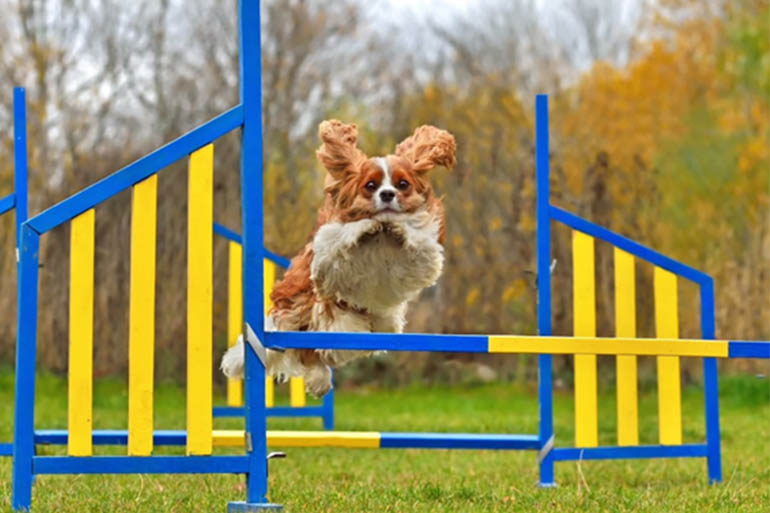
An obstacle course for dogs isn’t just for fun — they offer a wide range of physical and mental benefits that can improve your dog’s overall well-being. Whether you have a highly energetic breed or a more laid-back pup, incorporating dog agility activities into your furry friend’s routine can lead to a happier, healthier, and more well-balanced pooch. Here’s a look at the key benefits of introducing your dog to an obstacle course.
Physical Health Benefits
1. Improved Cardiovascular Health
- Why It Matters: Running, jumping, and navigating through a dog obstacle course can get your dog’s heart pumping. Regular cardiovascular exercise helps maintain a healthy weight, strengthens the heart, and improves overall endurance.
- Benefit: A healthy cardiovascular system can extend your dog’s lifespan and reduce the risk of heart disease.
2. Enhanced Muscle Tone and Strength
- Why It Matters: Using dog agility equipment challenges your dog to use different muscle groups, promoting overall muscle development and strength.
- Benefit: Strong muscles support joint health and reduce the risk of injury, particularly in active or working breeds.
3. Increased Flexibility and Agility
- Why It Matters: Moving through tunnels, weaving between poles, and leaping over dog jumps requires your dog to be agile and flexible.
- Benefit: Improved flexibility and agility can help prevent injuries during daily activities and other forms of exercise.
4. Weight Management
- Why It Matters: Regular physical activity is essential for burning calories and maintaining a healthy weight, especially in dogs prone to obesity and it’s estimated that more than half of all dogs in the United States are obese or overweight.
- Benefit: Keeping your dog at a healthy weight can prevent obesity-related health issues, such as diabetes and joint problems, and running around a dog agility course provides a complete whole-body workout.
5. Better Balance and Coordination
- Why It Matters: Navigating an obstacle course for dogs requires your pooch to balance on uneven surfaces, move precisely, and coordinate their movements.
- Benefit: Improved balance and coordination help your dog move more confidently and can reduce the likelihood of slips and falls.
Mental Health Benefits
1. Mental Stimulation
- Why It Matters: Dog agility training challenges your dog’s mind as well as their body. Figuring out how to navigate the course and responding to commands provides significant mental stimulation.
- Benefit: Mental stimulation helps prevent boredom and can reduce the likelihood of destructive behaviors that stem from a lack of engagement.
2. Increased Focus and Attention
- Why It Matters: Successfully completing an obstacle course requires your dog to focus on your commands and the tasks at hand.
- Benefit: Improved focus and attention can enhance your dog’s overall obedience and responsiveness, making training in other areas easier.
3. Confidence Building
- Why It Matters: Successfully navigating an obstacle course can boost your dog’s confidence, especially in shy or anxious dogs.
- Benefit: Increased confidence can lead to a more well-adjusted dog, reducing fear-based behaviors and improving their social interactions with other dogs and people.
4. Strengthening Your Bond
- Why It Matters: Working together to navigate an obstacle course can strengthen the bond between you and your dog, as it requires trust, communication, and teamwork.
- Benefit: A stronger bond can improve your dog’s overall behavior and happiness, as they feel more secure and connected with you.
5. Reduced Anxiety and Stress
- Why It Matters: Physical exercise and mental engagement can help reduce stress and anxiety in dogs, providing them with a positive outlet for their energy.
- Benefit: A less anxious dog is generally happier, more relaxed, and less likely to develop stress-related health issues.
Obstacle courses for dogs offer a comprehensive workout for your dog’s body and mind, providing numerous benefits that contribute to their overall health and well-being. Incorporating this activity into your dog’s routine can lead to a more active, engaged, and confident pet. Every dog, regardless of age or breed, can benefit from the challenges and rewards of an agility course.
Our Dog Agility Equipment
At Carlson Agility, we have everything you might need for your agility training facility or backyard training. All of our agility dog training equipment is built to competition standards, and our selection includes all of the following items.
- Dog Agility Jumps (including a Tire Jump)
- Dog Agility Weave Poles
- Dog Agility A-Frames
- Dog Agility Teeter Totters
- Pause Tables
- Agility Dog Walks
For smaller breeds, we offer a full selection of quality mini agility equipment. We also sell several helpful training tools including guide wires and training chutes for dog weave poles, wobble boards, planks and more.
As they begin building a backyard agility course, many of our customers are uncertain about which items to purchase first. We typically recommend at least one jump, as this is the most common obstacle on any given agility course. You also could opt for a dog agility starter kit, and we have several options. These include three or four pieces of equipment, and they can be a great option when you are just starting out with agility.
Get Started With Dog Agility!
Take the plunge and get your dog out there enjoying agility! Keep in mind, there’s no perfect obstacle to begin with and there’s not just one effective training method. Every dog is unique and what works with one dog might not with another dog. We recommend keeping training sessions short and remembering the three P’s – Practice, Patience and Praise. You’ll need plenty of short practice sessions, a handful of patience and a dash of praise for a job well done. Whether you start with a few jumps and a teeter or even tackle the weave poles as your first obstacle, building an obstacle course for dogs is always a good idea. Even if you never set foot (or paw) on a competition course, you will be providing your dog with one of the best possible sources of exercise and mental stimulation.





